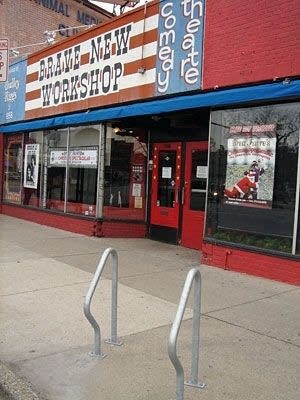What is sustainable theater? 5 questions for Leah Cooper

The Minnesota Theater Alliance, headed by Leah Cooper, has announced it's hosting a national conference on sustainability in theater this spring. The tag line for the two-day event is "Inspiration and innovation from around the world on how greener practices can make your work and our communities more sustainable."
I asked Cooper to answer a few questions about the conference and how sustainability applies to theaters. Here are her responses:
1. Why are you holding the conference?
Create a More Connected Minnesota
MPR News is your trusted resource for the news you need. With your support, MPR News brings accessible, courageous journalism and authentic conversation to everyone - free of paywalls and barriers. Your gift makes a difference.
Sustainable practices are changing the way many industries approach their work, their missions, and their communities, and the perforing arts industry is lagging behind in this area that is critical to survival. Minnesota is home to many leaders in sustainability, so hosting the conference here is a great opportunity to bring those leaders together with our industry.
The conference came about through discussions among members of the Twin Cities Sustainable Theatres group, a working group of theaters already working in this area. When Brave New Workshop, a member of the group, announced they were opening a new green event center with webcasting capabilities, it seemed like the perfect time and place.
[image]
You can learn about how the Brave New Workshop has been working on becoming a sustainable theater by clicking here.
2. What does sustainable theater look like?
We're still learning what it looks like. And it varies based on what organizations can afford to do and where they can make changes that have the greatest immediate impact.
There's the obvious stuff like recycling, composting, using less materials, less toxic materials, more sustainable materials for paper, paint, lumber, concessions, cleaning.
For organizations with facilities, there's energy reduction through newer fixtures, better HVAC, insulation, LED lighting, turning off lights and monitors at night.
The less obvious and also more interesting things are new business models that reduce transportation, shipping, better management of human resources (which also need to be sustainable).
And even more interesting is considering sustainable themes as inspiration for art-making - sets made entirely of found materials, community participation in art making, shows with ecological themes. There are some super inspiring examples from all over the world that we will be sharing through webcasting.
[image]
Leah Cooper
3. What are the biggest challenges theaters face to "going green?" What waste are theaters creating?
The biggest challenge is that it's not as simple as just recycling paper and that there's no one best solution for everyone. To do it successfully requires a change in the way an organization approaches everything it does - a paradigm shift in thinking and a culture shift in doing. Another challenge is that nonprofits think it's expensive to go green and that they'll never be able to do it. Many changes don't have a cost; in fact, some yield cost savings that can make it possible to have extra funds to spend on initiatives that do have a cost.
The biggest environmental impact theaters are making varies depending on activities. For some, they're just wasting a lot of energy heating an old building. For others it's using tons of lumber from unsustainable sources and toxic paint to build sets that they throw out after every show. For others, it's using incandescent lights when LED would work better with a fraction the energy. For those with big admin infrastructure, it's paper and electricity for computer monitors left on all night. For those that travel a lot, carbon emissions from airplanes and cars is the biggest impact. The most important first step is a commitment to changing the way they think. The second is to assess what they are doing now and how it is impacting both the environment and their own survival.
4. It sounds like this is not just about the environment, but about survival - how are the two connected?
Currently, most individuals and organizations don't pay the real cost of materials and energy we use, or waste we produce. So survival for the planet and survival for an organization might not seem connected. But increasingly, we will pay through hard costs of inefficient resource usage, through health impacts on our artists, staff, and audiences; through loss of philanthropic support as granters and donors start asking for accountability in this area.
Also, we work in the field of human inspiration and learning. We can not inspire and learn if are culture and business models are out of date, disconnected from our environment, and wasteful. Lastly, as innovators and, as local theater director Ben Krywosz calls those of us in the arts, "soul workers," we should be inspiring our communities to see themselves connected to a healther more holistic community that cares for its resources.
5. What do you hope to see come out of this conference?
I hope theaters are inspired to start engaging in these critical and empowering ideas and efforts. And then I hope they work collectively to start taking action. Day 1 of the conference is a series of presentations about what's been done elsewhere and what's possible - that's the inspiration part. Day 2 will be peer-to-peer brainstorming sessions with experts from other fields to discuss what we can do next, together.
By the way, what makes this national is that Day 1 will be live Webcast, Day 2 will have concurrent breakouts at regional partners around the country with national collaboration over the Web. We hope to make the whole conference a model for remote presentation and collaboration - another great way to reduce carbon emissions and be efficient.